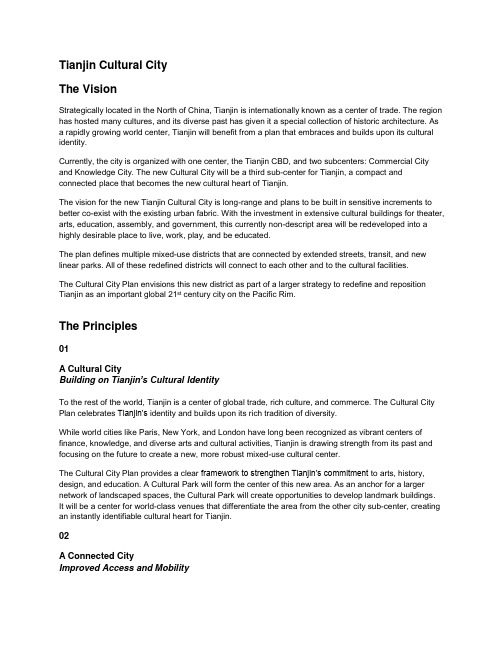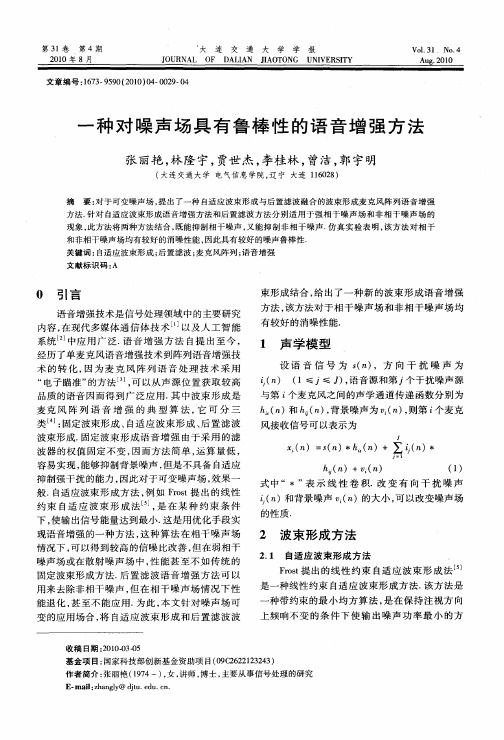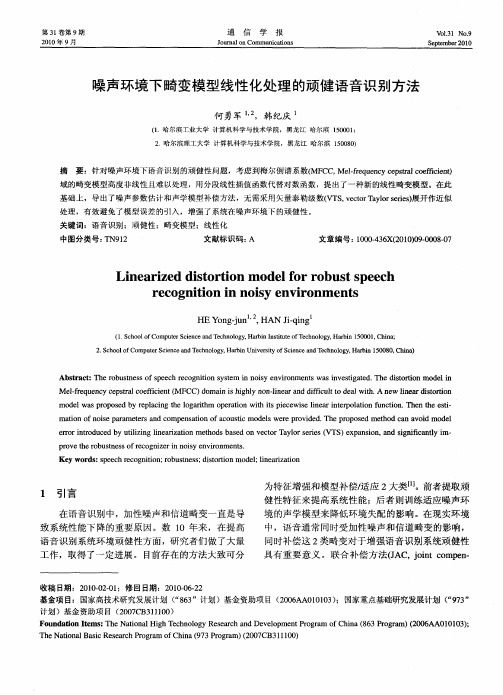SPEECH ENHANCEMENT IN VEHICULAR ENVIRONMENT
- 格式:pdf
- 大小:203.59 KB
- 文档页数:5

Tianjin Cultural CityThe VisionStrategically located in the North of China, Tianjin is internationally known as a center of trade. The region has hosted many cultures, and its diverse past has given it a special collection of historic architecture. As a rapidly growing world center, Tianjin will benefit from a plan that embraces and builds upon its cultural identity.Currently, the city is organized with one center, the Tianjin CBD, and two subcenters: Commercial City and Knowledge City. The new Cultural City will be a third sub-center for Tianjin, a compact and connected place that becomes the new cultural heart of Tianjin.The vision for the new Tianjin Cultural City is long-range and plans to be built in sensitive increments to better co-exist with the existing urban fabric. With the investment in extensive cultural buildings for theater, arts, education, assembly, and government, this currently non-descript area will be redeveloped into a highly desirable place to live, work, play, and be educated.The plan defines multiple mixed-use districts that are connected by extended streets, transit, and new linear parks. All of these redefined districts will connect to each other and to the cultural facilities.The Cultural City Plan envisions this new district as part of a larger strategy to redefine and reposition Tianjin as an important global 21st century city on the Pacific Rim.The Principles01A Cultural CityBuilding on Tianjin’s Cultural IdentityTo the rest of the world, Tianjin is a center of global trade, rich culture, and commerce. The Cultural City Plan celebrates Tianjin’s identity and builds upon its rich tradition of diversity.While world cities like Paris, New York, and London have long been recognized as vibrant centers of finance, knowledge, and diverse arts and cultural activities, Tianjin is drawing strength from its past and focusing on the future to create a new, more robust mixed-use cultural center.The Cultural City Plan provides a clear framework to strengthen Tianjin’s commitment to arts, history, design, and education. A Cultural Park will form the center of this new area. As an anchor for a larger network of landscaped spaces, the Cultural Park will create opportunities to develop landmark buildings.It will be a center for world-class venues that differentiate the area from the other city sub-center, creating an instantly identifiable cultural heart for Tianjin.02A Connected CityImproved Access and MobilityNew street and transit connections will improve citywide mobility. The plan calls for a metro system with stations strategically located in high-density, mixed-use developments.Adjustments to the existing street hierarchy address areas where existing traffic patterns could be improved. Greenways will make city streets safer for pedestrians and bicycle traffic, while also helping to improve vehicular circulation. The plan also makes connections to surrounding neighborhoods a key priority by expanding the open space network.03A New Mixed-Use Center for TianjinCulture, Health, Commerce, and EducationThe plan calls for a variety of land uses in close proximity, with a rich mix of building and architectural types. By blending and balancing different uses—such as cultural venues, health care facilities, commercial uses, residential neighborhoods, and schools—the new City Center will be a desirable place to live, work, and play.The plan extends Jianshan Road south to establish a new mixed-use commercial center, creating jobs, services, and housing for Tianjin. Using Jianshan Road as a focal point for a variety of uses and activities will help to focus the urban fabric and create a more walkable city.04Seven Vibrant DistrictsDiverse Neighborhoods with Unique IdentitiesThe plan advocates seven high-quality neighborhoods focused on culture, health, recreation, and education.1. North Jianshan District: Office Use, SOHO, and Educational Uses2. South Jianshan District: Office, Residential ,and Educational Uses3. North Cultural Park District: Retail, Entertainment, and SOHO4. South Cultural Park District: Institutional, Health Care, and Residential Uses5. Government District: Government and Mixed Uses6. South Government District: Residential and Mixed Uses7. North Residential District: Residential and Mixed UsesExtensive cultural facilities are designed to serve all ages, including children, teenagers, adults, tourists, and residents. A commercial street along Jianshan Road will be a high-density center for work, shopping, and leisure. Healthcare facilities are envisioned as 24-hour “cities” tha t offer research, medical education, patient care, hotels, and medical office buildings.By carefully rebuilding existing places and encouraging most residential buildings to be mid-rise 4-6 story structures, the plan honors Tianjin’s tradition of low-rise, high-density neighborhoods. Schools will also be located within the neighborhoods to provide convenient and high-quality education for families and children.05Green LandscapeAn Enhanced Open Space NetworkThe enhancement and connection of existing green spaces (public, private, and semi-private) will create a web of parks that serve the city as a whole. The plan introduces a connected park system that extends from the Cultural Park, greens the city, and reaches the surrounding waterways.This enhance d park system will build upon the city’s commitment to creating quality public open spaces. New greenways and tree-lined boulevards are designed to provide important connections to surrounding neighborhoods and distinguish the Cultural City’s natural chara cter.Eventually, this strategy for expanding the open space network will extend beyond the Cultural City, providing a model for Tianjin to integrate nature into the environment in meaningful and healthy ways.06Building the City’s Distinctive ImagePedestrian Scaled Buildings and BlocksTianjin’s urban fabric historically retains a pleasant scale of buildings and streetscapes. Typically low-to-mid rise, this scale of buildings relates to the human scale and helps to shape the character of public streets and parks. The redevelopment of the Cultural District strives to build upon the “Tianjin scale” by creating an abundance of buildings in the 4-8 story range, while also adding a few distinct districts for taller buildings.07Sustainable DesignIntelligent District InfrastructureThe introduction of smart, sustainable infrastructure systems that link high-performance buildings will enhance the overall livability of the City. The plan focuses on 8 key performance metrics that will help to build a long-term framework for intelligent infrastructure.1. Energy Efficiency: District cooling, on-site energy generation, heat recovery, and efficientbuilding strategies are key components of reducing energy consumption and cutting carbonemissions.2. Water Use Reduction: Efficient fixtures and process water reduction will reduce potable waterconsumption and wastewater generation. Greywater reuse and rainwater harvesting will alsoimprove the effectiveness of water management.3. Waste Management: Waste management will divert waste from landfills and facilitate recyclingefforts.4. Renewable Energy: On-site renewable energy generation will decrease grid energy dependenceand overall carbon emissions, aligned with Tianjin’s and China’s policies.5. Walkable and Transit-Oriented Development: Tianjin Cultural City is accessible by multiplemodes of alternative and public transportation. This framework will help to reduce GHG emissionsand improve air quality and health.6. Landscape and Open Space: Re-forested parks, new open green areas, tree-lined boulevards,and reduced building footprints will create environmental harmony and reduce urban heat islands.7. High-Density and Urban Redevelopment: Revitalization of the urban core and high-densityplanning decreases the pressure to build new infrastructure and maximizes existing networks.8. Well Being: A healthy, happy, and prosperous community permeates the entire environment andcan be measured through higher productivity levels and better school performance.08Smart, Incremental GrowthNew Development Integrated with Existing CityLong and short-term development strategies and phased development will help retain the existing neighborhood character while also allowing new growth and change where it is needed.By providing opportunities for phased construction, the Cultural City Plan maximizes the value of existing facilities while allowing renovated and new facilities to be built while older buildings remain operational. Incremental growth also allows the City to adapt and evolve in budgeted phases, while obtaining funding and approvals as well as full civic and public support.。

车内噪声环境下的语音端点检测和增强技术
马龙华;臧义华;刘利强
【期刊名称】《计算机工程与应用》
【年(卷),期】2007(43)36
【摘要】随着现代科技的发展,车载电子设备越来越多,但是如果在驾驶中司机的手离开方向盘去操作这些电子设备却是很危险的.对于这个问题的一个解决方法就是这些设备都采用语音识别作为它们的输入接口.通常的语音识别系统在噪声环境下的识别率是很低的,造成识别率下降的一个重要原因就是端点检测的不准确,因此必须发展一些技术来解决这个问题.提出了一种基于子带美尔谱熵的算法,这种算法可以准确地检测到语音的起始点和结束点,得到语音端点就可以利用谱减的方法来进行语音增强,经过增强后的语音信号就可以用普通的语音识别系统进行识别.
【总页数】3页(P217-219)
【作者】马龙华;臧义华;刘利强
【作者单位】哈尔滨工程大学自动化学院,哈尔滨,150001;华北计算技术研究所指挥自动化研究室,北京,100083;哈尔滨工程大学自动化学院,哈尔滨,150001
【正文语种】中文
【中图分类】TN912
【相关文献】
1.一种强噪声环境下的语音端点检测算法 [J], 蔡萍
2.飞机驾驶舱噪声环境下的飞行员语音端点检测 [J], 诸心阳;黄丹;陆燕玉;傅山
3.瞬态噪声环境下改进的语音端点检测算法 [J], 李丹;圣明明;刘曼
4.瞬态噪声环境下改进的语音端点检测算法 [J], 李丹; 圣明明; 刘曼
5.噪声环境下多特征融合的语音端点检测方法 [J], 罗思洋;龙华;邵玉斌;杜庆治因版权原因,仅展示原文概要,查看原文内容请购买。



第29卷第6期江苏理工学院学报JOURNAL OF JIANGSU UNIVERSITY OF TECHNOLOGY Vo l.29,No.6 Dec.,20232023年12月近年来,随着网络通信技术与智能交通系统的快速发展,车载自组织网络(Vehicular Ad Hoc Network,VANET)愈发受到广泛的关注[1]。
VANET 作为一种快速组网技术,用于实现车联网环境下的车与车通信(V2V)、车与路侧单元通信(V2R)、车与行人通信(V2P)等,使得车辆能够感知视距范围外的交通信息,从而很大程度上减少了交通事故,提高了交通效率和安全性[2]。
在车联网环境中,车辆间通过广播基础安全消息(Basic Safety Message,BSM)或合作感知信息(Cooperative Awareness Message,CAM)帮助驾驶员做出及时准确的驾驶决策,2种信标消息都包含相同的内容(包括发送车辆的位置和行驶状态)[3]。
然而,由于车辆的高速移动性、网络拓扑的动态变化性以及无线信道的开放性等,车载自组织网络的部署面临着多种网络安全问题和挑战[4]。
此外,由于VANET缺乏相应的安全基础设施,车联网中的内部节点容易遭受多种网络攻击[5],如拒绝服务攻击、虚假信息欺骗攻击等[6]。
在欺骗攻击中,被攻击车辆通过广播虚假消息误导周边车辆,极容易造成严重的交通事故。
此类网络攻击往往无法使用消息加密技术进行防范,因为其发生在VANET的内部。
这些节点是经过合理认证的内部成员,拥有有效的网络访问密钥凭证[7],能够在网络中传输合法信息并进行通信。
因此,需要利用攻击检测系统对联网车辆的信标消息进行检验,过滤不合理消息,进而起到保障车辆网络安全的效果。
现有的攻击检测机制可归结为2种类型:以数据为中心、以节点为中心。
以数据为中心的检测机制对信标消息的数据语义进行可信度评估,以确保传输数据的正确性和连续性。
以数据为中心车联网环境下基于CNN-LSTM的行驶信息欺骗攻击检测梁乐威1,陈宇峰2,向郑涛1,游康祥1,周旭1(1.湖北汽车工业学院电气与信息工程学院,湖北十堰442002;2.湖北汽车工业学院汽车工程师学院,湖北十堰442002)摘要:当联网车辆遭受网络攻击时,会向外广播虚假行驶信息,从而误导周边车辆,极易引发交通事故。

doi:10.3969/j.issn.1003-3106.2023.09.009引用格式:陈佳佳,张海剑,华光.基于Conformer的时域多通道语音分离方法[J].无线电工程,2023,53(9):2054-2060.[CHENJiajia,ZHANGHaijian,HUAGuang.Time domainMulti channelSpeechSeparationUsingConformer[J].RadioEngineering,2023,53(9):2054-2060.]基于Conformer的时域多通道语音分离方法陈佳佳,张海剑,华 光(武汉大学电子信息学院,湖北武汉430072)摘 要:多通道语音中的空间特征信息为说话人分离提供了重要的线索,为了更好地提取通道间信息并有效降低网络的处理时延,提出一种多通道时域语音分离方法。
利用多层编码器实现语音特征提取并挖掘通道间信息,在逐层编码过程中获得不同时间分辨率的语音特征并降低特征时间维度;引入Conformer结构对语音全局时间关系进行建模,在解码阶段使用特征加权跳跃连接融合对应编码层的输出特征进行解码,并将高维语音特征恢复为时域信号。
在基于LibriSpeech仿真的多通道混响带噪语音数据集中进行实验,实验结果表明,所提方法通过多层编解码机制充分利用了多通道语音信息并降低了网络处理时延,通过Conformer实现并行数据处理和全局时间关系建模,在推理速度、分离语音质量和语音感知质量方面均优于基线单通道和多通道时域语音分离算法。
关键词:语音分离;Conformer;多通道;多层编码器中图分类号:TN912.3文献标志码:A开放科学(资源服务)标识码(OSID):文章编号:1003-3106(2023)09-2054-07Time domainMulti channelSpeechSeparationUsingConformerCHENJiajia,ZHANGHaijian,HUAGuang(ElectronicInformationSchool,WuhanUniversity,Wuhan430072,China)Abstract:Thespatialinformationofmulti channelaudiosprovidesimportantcluesforspeakerseparation.Inordertobetterextracttheinter channelinformationandgetlowerprocessingdelay,amulti channeltime domainspeechseparationmethodisproposed.Firstofall,themultilayerencoderisusedtoextractspeechfeaturesandspatialinformation.Intheprocessoflayerbylayerencoding,speechfeatureswithdifferenttimeresolutionareobtainedandthefeaturetimedimensionisreduced.ThentheConformerstructureisusedtomodelthetemporalsequence.Inthedecodingstage,decoderlayer’sinputisweightedbycorrespondingencoderlayeroutput,andthemultilayerdecoderisusedtorestorehigh dimensionalspeechfeaturestotimedomainsignals.ExperimentsarecarriedoutonasimulateddatasetusingthecleanLibriSpeechcorpusthatismixedwithadditivenoisesunderreverberantconditions.Experimentalresultsshowthattheproposedmethodeffectivelyrealizestheextractionofmulti channelspeechinformationandreducesthenetworkprocessingdelaythroughthemulti layercodingmechanism,implementsparalleldataprocessingandglobaltemporalrelationshipmodelingbasedonConformerstructure,andoutperformsthebaselinesingle channelandmulti channeltime domainspeechseparationalgorithmsininferencetime,separationperformanceandtheperceptualspeechquality.Keywords:speechseparation;Conformer;multi channel;multilayerencoder收稿日期:2023-03-01基金项目:湖北省自然科学基金(2022CFB084)FoundationItem:HubeiProvincialNaturalScienceFoundationofChina(2022CFB084)0 引言人类的听觉系统可以轻松地从有噪声或者其他人声干扰的复杂声学环境中分离出目标声源信号,然而对于机器来说,这仍是一个极具挑战性的任务。
SEC. 51A-10.102 PURPOSEThe process of development with its alteration of the natural topography, vegetation, and creation of impervious cover can have a negative effect on the ecological balance of an area by causing increases in air temperatures and accelerating the processes of runoff, erosion, and sedimentation. The economic base of the city can and should be protected through the preservation conservation and enhancement of the unique natural beauty, environment, and vegetative space in this area. Recognizing that the general objectives of this article are to promote and protect the health, safety, and welfare of the public, the city council further declares that this article is adopted for the following specific purposes:(1) To aid in stabilizing the environment's ecological balance by contributing to the processes of air purification, oxygen regeneration, ground-water recharge, and storm water runoff retardation, while at the same time aiding in noise, glare, wind, and heat abatement.(2) To provide visual buffering between land uses of differing character to alleviate the harshness of urban life.(3) To enhance the beautification of the city.(4) To safeguard and enhance property values and to protect public and private investment.(5) To conserve energy.(6) To provide habitat for wildlife.(7) To encourage the preservation of large trees which, once removed, can be replaced only after generations.(8) To conserve water.(9) To recognize and conserve the urban forest as part of the city's natural/green infrastructure.SEC. 51A-10.103 ACCEPTABLE PLANT MATERIALS(a) No artificial plant materials may be used to satisfy the requirements of this article.(b) In satisfying the requirements of this article, the use of high-quality, winter-hardy, and heat and drought-tolerant plant materials is recommended and encouraged.SEC. 51A-10.104 SOIL AND PLANTING AREA REQUIREMENTS(a) Planting areas dedicated to the growth of roots may consist of surface soil areas, covered soil areas, and root paths. The planting areas must have native soils, prepared soils, or structural soils, and may include permeable pavement, sidewalk support, and soil cells.(ab) Planting areas in general must have the following soil depths and dimensions:(1) For each large shrub or small tree installation, a minimum of 24 inches of soil depth and 16SEC. 51A-10.105 PROTECTION OF PLANTING AREASRequired areas for plant materials must be protected from vehicular traffic through the use of concrete curbs, wheel stops, or other permanent barriers.SEC. 51A-10.106 IRRIGATION REQUIREMENTSExcept as otherwise stated in this section, automatic irrigation systems with dedicated water zones are required for all non-residential landscape designs that include landscape areas of 500 square feet orPedestrian pathways must be a minimum of three feet in width and a maximum of 15 feet in width.SEC. 51A-10.108 GENERAL MAINTENANCE(a) Required plant materials must be maintained in a healthy, growing condition at all times. The property owner is responsible for regular weeding, mowing of grass, irrigating, fertilizing, pruning, and other maintenance of all plantings as needed. Any plant that dies must be replaced with another livingplant that complies with this article and the approved landscape plan, if any, within 90 days after notification by the city.(b) Any damage to utility lines resulting from the negligence of the property owner or his agents or employees in the installation and maintenance of required plant materials in a utility easement is the responsibility of the property owner. If a public utility disturbs a landscaped area in a utility easement, it shall make every reasonable effort to preserve the plant materials and return them to their prior locations after the utility work. If, nonetheless, some plant materials die, it is the obligation of the(D4) The extent to which other existing or proposed amenities will compensate for the reduction of landscaping.(b) Tree Conservation.(1) The board may grant a special exception to the requirements of tree conservation of this article upon making a special finding from the evidence presented that:(A) strict compliance with the requirements of this article will unreasonably burden the use of the property;(B) the special exception will not adversely affect neighboring property; and(C) the requirements are not imposed by a site-specific landscape plan approved by the city plan commission or city council.(2) In determining whether to grant a special exception under Subsection (a), the board shall。
SPEECH ENHANCEMENT IN VEHICULAR ENVIRONMENT
Abdul Wahab and Tan Eng ChongSchool of Applied Science, Nanyang Technological University, Nanyang Avenue, Singapore 639798andHüseyin AbutE.C.E. Department, San Diego State University, San Diego, CA92182
AbstractThe increasing demand for mobile multimediacommunication prompted extensive studies onimplementing effective and optimum way to communicatein the vehicular environment. The proposed system coverthe analysis and cancellation/suppression of the variousnoise in a vehicular environment ranging from enginenoise, wind noise to road noise. In addition it is critical toalso understand the echoes that can be generated due tothe effect of a vehicle chamber. All these noises andunwanted signals impede on the speech performance andhave been a cause of clarity in speeches even on anuncompressed voice. The compressed speech uses theLPC algorithm in the VOCODER and these worsen thespeech clarity and could be disastrous, where speech couldbe totally unrecognisable. Hence, the intelligent dashboardwould require microphone arrays and a multi-taskingsystem to handle the vast processing requirement.Numerous asynchronous scheduling tasks necessitate thearchitecture to be re-configurable. A cost-effectivetechnology for this would be to employ a powerful digitalsignal processing (DSP) sub-system equipped with thenecessary support electronics.
1.IntroductionIt has been in the public debate for some time that vehiclesin the future would need to detect, process, andcommunicate significantly more information. They will bebetween the vehicle and the driver, among the people inthe vehicle and between the vehicle and the outside world,including other vehicles, road itself, and the AdvancedTraffic Management and Information Systems (ATMIS).
The driver and other passengers may want to communicatewith the outside world verbally, or to have a conferencecall. These activities have been traditionally handled bycar phones or short-wave radios, where the underlyingsignal is the band-limited voice grade waveform. Thesesignals are transmitted over a communication channel,which is extremely corrupted by echoes both in thetransmission link and inside the chamber of the vehicle,natural and man-made noise from numerous sources, andinterfering signals from other channels, passengers, andaudio information subsystem. It is commonly accepted that
the next generation car phones will be totally digitalcellular and the volume of applications will increase.However, a number of ills will not go away and a speechprocessing system will be required to tackle them. Some ofthe tasks for this system will be the noise suppression,echo cancellation, source localisation, speakeridentification, speech coding, compression andtransmission by digital means.
We will discuss briefly the spectral dissection of variousdegradations in vehicular environment. A proposed cost-effective model for the speech processing andcommunication system and the re-configurable digitalsignal-processing concept will be introduced. Finally, theconclusion and summary of the proposed systemarchitecture.
2.Spectra of Vehicular DisturbancesIn order to justify various components of the proposedsystem, it would be appropriate to observe visually variousills mentioned above and vehicular echo problem.
To study the problem carefully and to gather road data, wehave performed a field test. We have equipped a compactvan with a DAT tape recorder and a low-cost low-passmicrophone. There were two passengers to act asinterference sources in addition to the driver. We havetravelled along the city streets and two expressways inSingapore for a number of hours. We have a database of40 minutes long recordings under 16 differentexperimental conditions. We have captured most of therecordings onto a hard disk using the speech I/O unit of adigital signal processing development system. We havesampled our data with a clock rate of 8,000 samples/s,which is the Nyquist frequency after properly band-limiting the signal to the voice-grade service bandwidth ofthe next generation digital cellular phones.
In Figure 1, we present in two plots the spectrum of theengine noise while the vehicle is moving at a nominalspeed of 60 km/h. The windows were rolled up and thechamber was quiet. There was not any other vehicle in thevicinity and it was not possible to detect wind noise insidethe vehicle. As it can be seen from these two plots, theengine noise does have any effect above 200 Hz. Thisshould be very easily tackled by the enhanced speechprocessing and communication system proposed here.